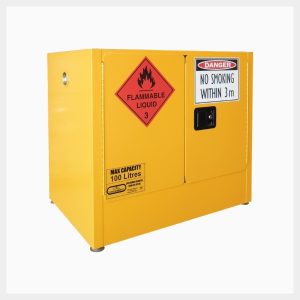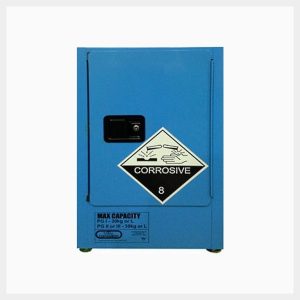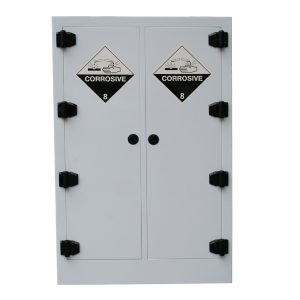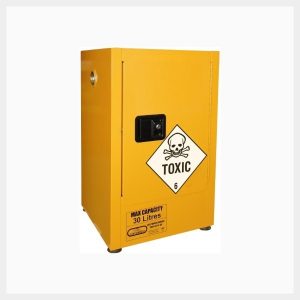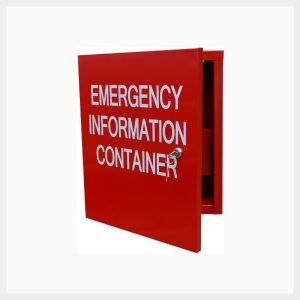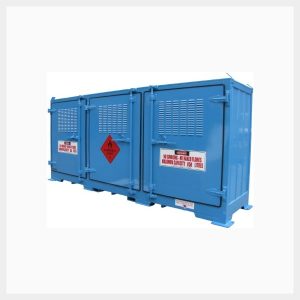The following list outlines the types of substances that should be stored in compliant DG cabinets:
- Class 3 Flammable Liquids
- Class 4.1 Flammable Solid
- Class 4.2 Spontaneously Combustible SubstanceClass 4
- .3 Dangerous When Wet
- Class 5.1 Oxidising Agent
- Class 5.2 Organic Peroxide
- Class 6 Toxic Substance
- Class 8 Corrosive Substance
- Class 9 Miscellaneous Dangerous Goods
The compliance requirements for all of the DG cabinets used to store these substances are set out by the corresponding storage and handling Australian Standard. Always research the materials or substances you work with in order to work safely in the workshop or laboratory. Below is a list of the more common incompatible chemicals. This is not a complete listing of chemical incompatibility of materials.
Chemicals listed should not be stored together with the others in the same DG cabinet.
Acetic acid – Chromic acid, nitric acid, hydroxyl compounds, ethylene glycol, perchloric acid, peroxides, permanganates
Acetic anhydride – Hydroxyl-containing compounds such as ethylene glycol, perchloric acid
Acetone – Concentrated nitric and sulfuric acid mixtures, hydrogen peroxide
Acetylene – Chlorine, bromine, copper, fluorine, silver, mercury
Alkali and alkaline earth metals such as powdered magnesium, sodium, potassium – Water, carbon tetrachloride or other chlorinated hydrocarbons, carbon dioxide, halogens
Ammonia (anhydrous) – Mercury, halogens, calcium hypochlorite, hydrofluoric acid
Ammonium nitrate – Acids, metal powders, flammable liquids, chlorates, nitrites, sulfur, finely divided organic or combustible materials
Aniline – Nitric acid, hydrogen peroxide
Arsenical materials – Any reducing agent
Azides – Acids, heavy metals and their salts, oxidizing agents
Calcium oxide – Water
Carbon, activated – All oxidising agents, calcium hypochlorite
Carbon tetrachloride – Sodium
Chlorates – Ammonium salts, acids, metal powders, sulfur, finely divided organic or combustible material
Chlorine dioxide – Ammonia, methane, phosphine, hydrogen sulfide
Chromic acid and chromium trioxide – Acetic acid, alcohol, camphor, glycerol, naphthalene, flammable liquids in general
Copper – Acetylene, hydrogen peroxide
Cumene hydroperoxide – Acids (organic or inorganic)
Cyanides – Acids
Flammable liquids – Ammonium nitrate, chromic acid, hydrogen peroxide, nitric acid, sodium peroxide, halogens, other oxidising agents
Fluorine – All other chemicals
Hydrides – Water
Hydrocarbons (e.g., butane, propane, benzene) – Fluorine, chlorine, bromine, chromic acid, peroxides
Hydrocyanic acid – Nitric acid, alkalis
Hydrofluoric acid (anhydrous) – Ammonia (aqueous or anhydrous)
Hydrogen peroxide – Copper, chromium, iron, most metals or their salts, any flammable liquid (i.e., alcohols, acetone), combustible materials, aniline, nitromethane
Hydrogen sulfide – Fuming nitric acid, oxidizing gases
Hypochlorites – Acids, activated carbon
Iodine – Acetylene, ammonia (aqueous or anhydrous), hydrogen
Mercury – Acetylene, fulminic acid, ammonia
Metal hydrides – Acids, water
Nitrates – Acids
Nitric acid (concentrated) – Acetic acid, acetone, alcohol, aniline, chromic acid, hydrocyanic acid, hydrogen sulfide, flammable liquids, flammable gases, copper, brass, any heavy metals
Nitrites – Acids
Nitroparaffins – Inorganic bases, amines
Oxalic acid – Mercury and silver and their salts
Oxygen – Oils, grease, hydrogen; flammable liquids, solids, or gases
Perchloric acid – Acetic anhydride, alcohol, bismuth, paper, wood, grease, oils
Permanganates – Concentrated sulfuric acid, glycerol, ethylene glycol, benzaldehyde
Peroxides, organic – Acids (organic or mineral), avoid friction, store cold
Phosphorus, white – Air, oxygen, alkalis, reducing agents
Potassium – Carbon tetrachloride, carbon dioxide, water
Potassium chlorate – Sulfuric and other acids, ammonium salts, metal powders, sulfur, finely divided organics, combustibles
Potassium perchlorate (see also chlorates) – Sulfuric and other acids
Potassium permanganate – Glycerol, ethylene glycol, benzaldehyde, sulfuric acid
Silver and silver salts – Acetylene, oxalic acid, tartaric acid, ammonium compounds, fulminic acid
Sodium – Carbon tetrachloride, carbon dioxide, other chlorinated hydrocarbons, water
Sodium nitrate – Ammonium nitrate and other ammonium salts
Sodium peroxide – Ethyl or methyl alcohol, glacial acetic acid, acetic anhydride, benzaldehyde, carbon disulfide glycerin, ethylene glycol, ethyl acetate, methyl acetate, furfural
Sulfides – Acids
Sulfuric acid – Chlorates, perchlorates, permanganates
*Adapted from Prudent Practices in the Laboratory: Handling and Disposal of Chemicals, National Research Council, 1995, with additions from OHS.

